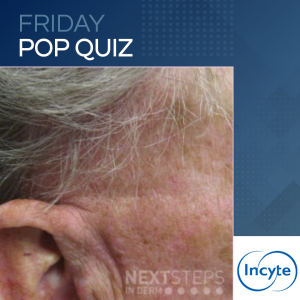
The correct answer is C. Frontal fibrosing alopecia (FFA).
The correct answer is FFA. When examining a patient with hair loss, one must determine whether there is evidence of scarring. This patient has decreased number of follicular openings in the affected areas with active disease as suggested by the scalp redness. The loss of follicular openings suggest a scarring alopecia. FFA is a scarring alopecia that affects the frontotemporal hairline and eyebrows. Other helpful clues to diagnose FFA include isolated ‘lonely’ hairs in the affected areas with erythema and scale surrounding hair follicles; conversely, scarred areas usually have less to absence of erythema and scale.
AA is a non-scarring alopecia that presents as circular or oval areas of hair loss. Exclamation point hair (distal hair shaft broader than proximal end) is another diagnostic clue. AnA is a very common non-scarring alopecia. It has been reported that 80% of Caucasian men are affected by age 70 years. AnA in men is due to hormonal effects of dihydrotestosterone, an androgen, that causes gradual miniaturization of hairs on the frontal/midline/vertex areas of the scalp. Significant erythema, scaling, and loss of follicular openings are not consistent with AnA. TE is a non-scarring alopecia that is sometimes associated with a precipitating event 3 months prior to the onset of diffuse hair shedding. TE presents with reduced hair density of the entire scalp and would not favor the frontotemporal hairline as in FFA. There is no history of traction in this scenario to suggest TA as the diagnosis.
References:
Bolduc C, Sperling LC, Shapiro J. Primary cicatricial alopecia: Lymphocytic primary cicatricial alopecias, including chronic cutaneous lupus erythematosus, lichen planopilaris, frontal fibrosing alopecia, and Graham-Little syndrome. J Am Acad Dermatol. 2016;75(6):1081-1099.
Tosti A, Piraccini BM, Iorizzo M, Misciali C. Frontal fibrosing alopecia in postmenopausal women. J Am Acad Dermatol. 2005;52(1):55-60. doi:10.1016/j.jaad.2004.05.014
Tan KT, Messenger AG. Frontal fibrosing alopecia: clinical presentations and prognosis. Br J Dermatol. 2009;160(1):75-79. doi:10.1111/j.1365-2133.2008.08861.x
